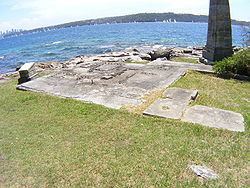 | ||
The Sydney Harbour anti-submarine boom net was an anti-torpedo and submarine defence net that was in Sydney Harbour during World War II. It spanned the entire width of the harbour from Green Point, Watsons Bay to Georges Head, on the northern side of Sydney Harbour. The boom formed part of the Sydney Harbour defences which also included artillery batteries and patrol boats.
Contents
History
Construction of the boom commenced in January 1942 and the boom and gates were fully operational by August 1942. For over three years, entry to Sydney Harbour was restricted by the boom net. All vessels including ships, ferries and fishing boats gained access to the harbour via one of three gates in the anti-torpedo and anti–submarine boom which spanned the harbour from Green Point to Georges Head.
On the night of 31 May 1942, three Japanese midget submarines attempted to enter the harbour in what became known as the Attack on Sydney Harbour. On the night of the attack the central section of the net was complete and support piles were in place to the west, but there were gaps of up to 400 metres (1,300 ft) wide on either side of the boom net. Material shortages, not lack of interest, prevented the completion of the boom net prior to the attack. The first submarine, the M 27, commanded by Lieutenant Jahai Chuma, was the first submarine to attempt entry. The M 27 followed another vessel into the harbour, but at some stage became entangled in the western end of the boom net's central section. Lieutenant Chuma tried to free his submarine by using a sawtooth metal cutter, which only entangled it further. By 8.30 pm he had attracted the attention of the watchman for the Maritime Service Board, James Cargill, who rowed across in a boat and discovered the Japanese submarine. Surprised, Cargill radioed naval headquarters. It took him two hours to convince the navy that there was a Japanese midget submarine caught in the boom net.
At 10:27 pm Chuma, realising that he had been detected, detonated charges, destroying the submarine and killing himself and his crew in the process. The two other midget submarines penetrated the then only partially completed boom net, and attacked shipping for several hours before being destroyed.
The boom net was removed after the end of the war in August 1945, and by early 1946, everything apart from the dolphins had been removed. The foundations of the winch house are the only remaining evidence of the anti-submarine boom net and they can still be seen on the shores of Green Point, along with other remaining evidence of military installations, such as underground fortifications and bunker complexes.
Adjacent to the winch house stood a stone marker that had existed for 90 years prior to the boom net's construction. Erected in 1850, this was used as a navigational leading mark for the Eastern Channel; it was lined up with the back mark which still stands on the west side of Parsley Bay.
Boom gates
The western gate was usually kept shut and was only opened for very large vessels that were damaged or under tow, which required the use of the deeper and straighter Western Channel. The western gate was opened by a tug boat. All other ships used the eastern gate, which was controlled by the boom gate vessel. The gate was opened by dragging it back to the hauling-back dolphin using winches housed on Green Point. The small craft gate was lowered to a depth of 5 metres (16 ft) with a winch mounted on board HMAS Kuramia.
Dimensions
The boom was 1,480 metres (4,860 ft) long, with two gate openings for ships. The gate on the Western Channel was 121 metres (397 ft) in length and was used for larger vessels. The gate on the eastern side of the channel (Eastern Channel) was 91 metres (299 ft) long, and there was another gate for smaller boats located on the western side of the boom gate vessel (tug boat), which was 30 metres (98 ft) long. The vessel used to pull theses gates open was HMAS Kuramia, a converted Sydney Harbour ferry, that had been used for public transportation from 1914. The central and western sections of the boom consisted of some 49 clusters of four piles with the net, which was made of wire and interlocking steel rings about 450 millimetres (18 in) in diameter, suspended between them. The eastern, Green Point, section of the net was suspended from buoys, as were the eastern and western gate nets.
